The global food packaging film market is valued at USD 68.3 billion in 2025 and is set to reach USD 133.1 billion by 2035, recording an absolute increase of USD 64.1 billion over the forecast period. This translates into a total growth of 93.9%, with the market forecast to expand at a compound annual growth rate (CAGR) of 6.90% between 2025 and 2035. According to FMI’s report series on packaging circularity and compliance under EU and US regulatory frameworks, the overall market size is expected to grow by approximately 1.9X during the same period, supported by increasing demand for convenience food packaging, growing adoption of barrier films for extended shelf life, and rising requirements for lightweight packaging solutions across fresh produce, frozen foods, dairy products, and bakery sectors.

Between 2025 and 2030, the food packaging film market is projected to expand from USD 68.3 billion to USD 95.7 billion, resulting in a value increase of USD 27.4 billion, which represents 42.7% of the total forecast growth for the decade. This phase of development will be shaped by increasing demand for modified atmosphere packaging solutions, rising consumption of packaged convenience foods enabling efficient preservation formats, and growing availability of advanced barrier coating technologies across commercial food packaging operations and specialty film production facilities.
Between 2030 and 2035, the market is forecast to grow from USD 95.7 billion to USD 133.1 billion, adding another USD 36.7 billion, which constitutes 57.3% of the overall ten-year expansion. This period is expected to be characterized by the advancement of high-barrier multilayer structures, the integration of active packaging technologies for freshness retention, and the development of enhanced sealability systems across diverse food categories. The growing emphasis on food waste reduction and recyclable film infrastructure will drive demand for advanced film varieties with enhanced oxygen barrier properties, improved moisture resistance credentials, and superior functionality characteristics.
Between 2020 and 2024, the food packaging film market experienced robust growth, driven by increasing consumer demand for ready-to-eat meal formats and growing recognition of packaging films' effectiveness in supporting safe food preservation across retail segments and foodservice applications. The market developed as businesses recognized the potential for food packaging films to deliver extended shelf life while meeting modern requirements for transparency and cost-effective production patterns. Technological advancement in coextrusion processes and lamination practices began emphasizing the critical importance of maintaining barrier performance while enhancing processing efficiency and improving material utilization.
| Metric | Value |
|---|---|
| Estimated Value in (2025E) | USD 68.3 billion |
| Forecast Value in (2035F) | USD 132.4 billion |
| Forecast CAGR (2025 to 2035) | 6.9% |
From 2030 to 2035, the market is forecast to grow from USD 95.7 billion to USD 132.4 billion, adding another USD 36.7 billion, which constitutes 57.3% of the overall ten-year expansion. This period is expected to be characterized by the advancement of high-clarity film formulations, the integration of easy-peel features for consumer convenience, and the development of specialized antimicrobial coatings for food safety applications. The growing emphasis on packaging functionality and processing precision will drive demand for premium varieties with enhanced puncture resistance credentials, improved heat seal strength options, and superior performance characteristics.
Between 2020 and 2024, the food packaging film market experienced significant growth, driven by increasing awareness of food preservation benefits and growing recognition of packaging films' effectiveness in supporting efficient supply chain operations across distribution segments and retail applications. The market developed as users recognized the potential for food packaging films to deliver economic advantages while meeting modern requirements for optical properties and reliable barrier protection practices. Technological advancement in printing processes and quality control systems began emphasizing the critical importance of maintaining color consistency while extending product freshness capabilities and improving customer satisfaction across diverse food categories.
Market expansion is being supported by the increasing global demand for hygienic food packaging solutions and the corresponding shift toward flexible films that can provide superior protection characteristics while meeting user requirements for product visibility and material-efficient production processes. Modern businesses are increasingly focused on incorporating packaging formats that can enhance supply chain efficiency while satisfying demands for consistent, reliably performing films and optimized logistics practices. Food packaging films' proven ability to deliver barrier protection, optical clarity, and diverse application possibilities makes them essential packaging for food processors and quality-conscious brand owners.
The growing emphasis on extended shelf life and packaging versatility is driving demand for high-performance food packaging film systems that can support distinctive product positioning and comprehensive brand differentiation across fresh produce, meat & poultry, and confectionery categories. User preference for films that combine functional excellence with processing flexibility is creating opportunities for innovative implementations in both traditional and emerging food packaging applications. The rising influence of e-commerce food retail and modern cold chain infrastructure is also contributing to increased adoption of food packaging films that can provide authentic protection benefits and reliable performance characteristics.
The market is segmented by film type, material composition, application method, end-use application, and region. By film type, the market is divided into flexible films, rigid films, shrink films, and stretch films. Based on material composition, the market is categorized into polyethylene (PE), polypropylene (PP), polyethylene terephthalate (PET), and polyamide (PA). By application method, the market includes form-fill-seal, lidding films, pouches, and wrapping films. By end-use application, the market encompasses fresh produce, bakery & confectionery, meat & poultry, dairy products, and frozen foods. Regionally, the market is divided into North America, Europe, Asia Pacific, Latin America, Middle East & Africa, and other regions.
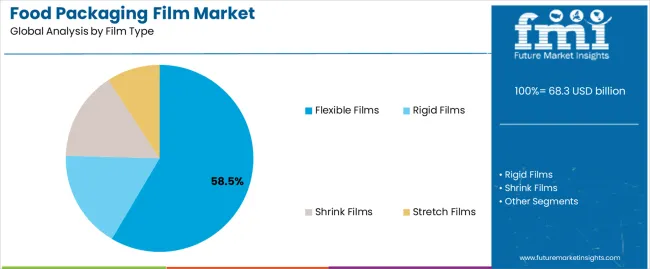
The flexible films segment is projected to account for 58% of the food packaging film market in 2025, reaffirming its position as the leading film category. Businesses and food packaging facilities increasingly utilize flexible films for their superior adaptability characteristics, established processing efficiency, and essential functionality in diverse packaging applications across multiple food categories. Flexible films' standardized manufacturing characteristics and proven cost-effectiveness directly address user requirements for reliable food protection and optimal packaging value in commercial applications.
This film segment forms the foundation of modern food packaging patterns, as it represents the format with the greatest commercial scalability potential and established compatibility across multiple filling systems. Business investments in process automation and barrier optimization continue to strengthen adoption among efficiency-conscious food processors. With users prioritizing material reduction and preservation performance, flexible films align with both economic objectives and protection requirements, making them the central component of comprehensive packaging strategies.

Fresh produce is projected to represent 43% of the food packaging film market in 2025, underscoring its critical role as the primary application for quality-focused businesses seeking superior freshness preservation benefits and enhanced visibility credentials. Commercial users and produce brands prefer fresh produce applications for their established consumption patterns, proven market acceptance, and ability to maintain exceptional respiration control profiles while supporting versatile product offerings during diverse retail experiences. Positioned as essential applications for discerning food packagers, fresh produce offerings provide both market penetration excellence and brand positioning advantages.
The segment is supported by continuous improvement in micro-perforation technology and the widespread availability of established food safety frameworks that enable freshness compliance and premium positioning at the consumer level. Additionally, packaging companies are optimizing film designs to support market differentiation and accessible pricing strategies. As packaging technology continues to advance and consumers seek convenient fresh food formats, fresh produce applications will continue to drive market growth while supporting brand recognition and consumer trust strategies.
The food packaging film market is advancing rapidly due to increasing food preservation consciousness and growing need for transparent packaging choices that emphasize superior barrier performance outcomes across fresh food segments and processed food applications. However, the market faces challenges, including competition from alternative packaging formats, regulatory pressures on plastic film usage, and raw material price volatility affecting production economics. Innovation in recyclable film integration and advanced coating systems continues to influence market development and expansion patterns.
The growing adoption of food packaging films in ready-to-eat meals and convenience food packaging is enabling businesses to develop distribution patterns that provide distinctive freshness preservation benefits while commanding consumer acceptance positioning and enhanced convenience characteristics. Convenience food applications provide superior barrier properties while allowing more sophisticated resealable features across various product categories. Users are increasingly recognizing the functional advantages of food packaging film positioning for premium product protection and efficiency-conscious distribution integration.
Modern food packaging film manufacturers are incorporating advanced active packaging technologies, oxygen scavenger integration, and smart indicator systems to enhance food safety credentials, improve shelf life outcomes, and meet commercial demands for traceable packaging solutions. These systems improve quality assurance while enabling new applications, including freshness monitoring and temperature tracking programs. Advanced packaging integration also allows manufacturers to support food safety leadership positioning and regulatory compliance beyond traditional film operations.
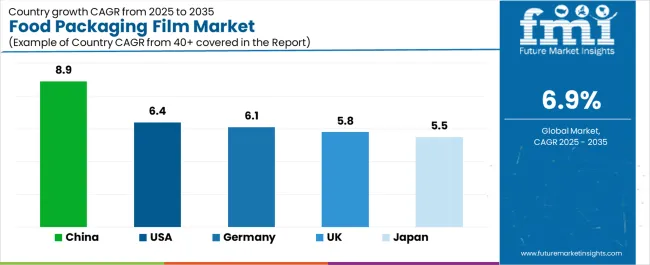
| Country | CAGR (2025-2035) |
|---|---|
| USA | 6.4% |
| Germany | 6.1% |
| UK | 5.8% |
| China | 8.9% |
| Japan | 5.5% |
The food packaging film market is experiencing robust growth globally, with China leading at an 8.9% CAGR through 2035, driven by the expanding food processing industry, growing packaged food consumption, and increasing adoption of modern retail formats. The USA follows at 6.4%, supported by rising demand for convenience foods, expanding cold chain infrastructure, and growing acceptance of flexible packaging solutions. Germany shows growth at 6.1%, emphasizing established food processing capabilities and comprehensive packaging development. The UK records 5.8%, focusing on premium packaged foods and distribution expansion. Japan demonstrates 5.5% growth, prioritizing quality packaging solutions and technological advancement.
The report covers an in-depth analysis of 40+ countries, the top-performing countries are highlighted below.
The food packaging film market consumption and sales in the USA is projected to exhibit exceptional growth with a CAGR of 6.4% through 2035, driven by the country's rapidly expanding convenience food sector, favorable consumer attitudes toward packaged products, and initiatives promoting packaging innovation across major food processing regions. The USA's position as a leading consumer market and increasing focus on extended shelf life packaging development are creating substantial demand for high-quality food packaging films in both commercial and specialty markets. Major food brands and processors are establishing comprehensive packaging capabilities to serve growing demand and emerging market opportunities.
The food packaging film market products in Germany is expanding at a CAGR of 6.1%, supported by rising food processing sophistication, growing fresh food packaging requirements, and expanding flexible packaging infrastructure. The country's developing barrier film capabilities and increasing commercial investment in advanced coating technologies are driving demand for food packaging films across both imported and domestically produced applications. International packaging companies and domestic food processors are establishing comprehensive operational networks to address growing market demand for quality food packaging films and efficient barrier solutions.
The food packaging film market products in the UK is projected to grow at a CAGR of 5.8% through 2035, supported by the country's mature retail food market, established distribution culture, and leadership in food safety standards. Britain's sophisticated supply chain infrastructure and strong support for packaging innovation are creating steady demand for both traditional and innovative food packaging film varieties. Leading food brands and specialty processors are establishing comprehensive operational strategies to serve both domestic markets and growing export opportunities.
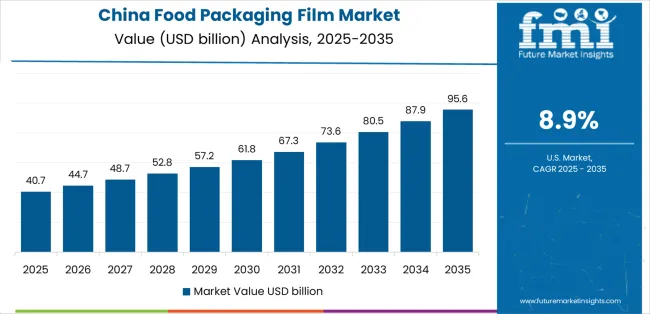
The food packaging film market products in China is projected to grow at a CAGR of 8.9% through 2035, driven by the country's emphasis on food industry expansion, manufacturing leadership, and sophisticated production capabilities for films requiring specialized barrier varieties. Chinese manufacturers and distributors consistently seek commercial-grade packaging that enhances product differentiation and supports retail operations for both traditional and innovative food applications. The country's position as an Asian manufacturing leader continues to drive innovation in specialty food packaging film applications and commercial production standards.
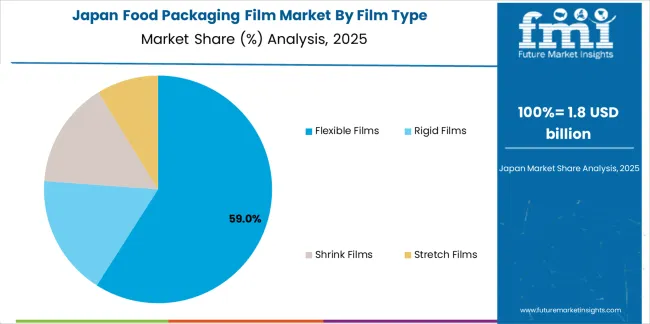
The food packaging film market products in Japan is projected to grow at a CAGR of 5.5% through 2035, supported by the country's emphasis on quality food processing, packaging standards, and advanced technology integration requiring efficient barrier solutions. Japanese businesses and food brands prioritize material performance and processing precision, making food packaging films essential packaging for both traditional and modern product applications. The country's comprehensive quality excellence and advancing packaging patterns support continued market expansion.

The Europe food packaging film market is projected to grow from USD 22.1 billion in 2025 to USD 41.8 billion by 2035, recording a CAGR of 6.6% over the forecast period. Germany leads the region with a 35.0% share in 2025, moderating slightly to 34.5% by 2035, supported by its strong food processing base and demand for premium, technically advanced packaging films. The United Kingdom follows with 21.0% in 2025, easing to 20.5% by 2035, driven by a sophisticated retail market and emphasis on food safety and barrier protection standards. France accounts for 19.5% in 2025, rising to 20.0% by 2035, reflecting steady adoption of flexible packaging solutions and distribution optimization.
Italy holds 12.0% in 2025, expanding to 12.8% by 2035 as fresh produce innovation and specialty food applications grow. Spain contributes 8.0% in 2025, growing to 8.5% by 2035, supported by expanding fresh produce sector and packaged food handling. The Nordic countries rise from 3.0% in 2025 to 3.2% by 2035 on the back of strong food safety adoption and advanced film technologies. BENELUX remains at 1.5% share across both 2025 and 2035, reflecting mature, efficiency-focused markets.
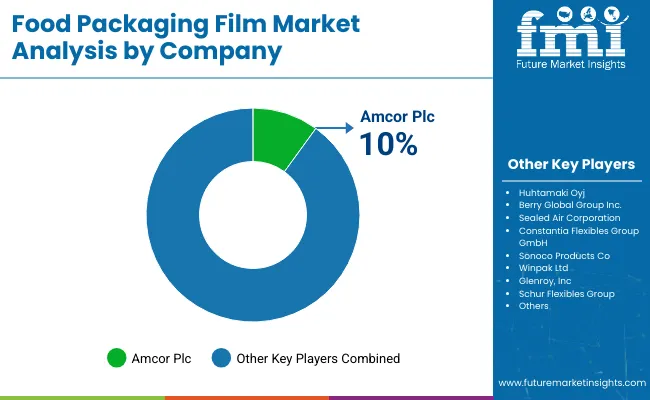
The food packaging film market is characterized by competition among established packaging manufacturers, specialized film producers, and integrated material solution companies. Companies are investing in coextrusion technologies, advanced barrier coating systems, product innovation capabilities, and comprehensive distribution networks to deliver consistent, high-quality, and reliable food packaging film systems. Innovation in oxygen barrier enhancement, moisture protection methods, and application-specific product development is central to strengthening market position and customer satisfaction.
Amcor plc leads the market with a strong focus on packaging innovation and comprehensive food packaging film solutions, offering commercial barrier systems with emphasis on manufacturing excellence and technological heritage. Sealed Air Corporation provides specialized protective packaging capabilities with a focus on global market applications and material engineering networks. Berry Global Inc. delivers integrated flexible packaging solutions with a focus on food positioning and operational efficiency. Bemis Company Inc. specializes in comprehensive flexible film manufacturing with an emphasis on commercial applications. Mondi Group focuses on comprehensive paper-based and film combinations with advanced design and premium positioning capabilities.
The success of food packaging films in meeting commercial packaging demands, consumer-driven freshness requirements, and performance integration will not only enhance food preservation outcomes but also strengthen global food packaging manufacturing capabilities. It will consolidate emerging regions' positions as hubs for efficient film production and align advanced economies with commercial packaging systems. This calls for a concerted effort by all stakeholders -- governments, industry bodies, manufacturers, distributors, and investors. Each can be a crucial enabler in preparing the market for its next phase of growth.
How Governments Could Spur Local Production and Adoption?
How Industry Bodies Could Support Market Development?
How Distributors and Food Industry Players Could Strengthen the Ecosystem?
How Manufacturers Could Navigate the Shift?
| Items | Values |
|---|---|
| Quantitative Units (2025) | USD 68.3 billion |
| Film Type | Flexible Films, Rigid Films, Shrink Films, Stretch Films |
| Material Composition | Polyethylene (PE), Polypropylene (PP), Polyethylene Terephthalate (PET), Polyamide (PA) |
| Application Method | Form-Fill-Seal, Lidding Films, Pouches, Wrapping Films |
| End-Use Application | Fresh Produce, Bakery & Confectionery, Meat & Poultry, Dairy Products, Frozen Foods |
| Regions Covered | North America, Europe, Asia Pacific, Latin America, Middle East & Africa, Other Regions |
| Countries Covered | United States, Germany, United Kingdom, China, Japan, and 40+ countries |
| Key Companies Profiled | Amcor plc, Sealed Air Corporation, Berry Global Inc., Bemis Company Inc., Mondi Group, and other leading food packaging film companies |
| Additional Attributes | Dollar sales by film type, material composition, application method, end-use application, and region; regional demand trends, competitive landscape, technological advancements in barrier coating engineering, active packaging integration initiatives, optical property enhancement programs, and premium product development strategies |
The global food packaging film market is estimated to be valued at USD 68.3 billion in 2025.
The market size for the food packaging film market is projected to reach USD 133.1 billion by 2035.
The food packaging film market is expected to grow at a 6.9% CAGR between 2025 and 2035.
The key product types in food packaging film market are flexible films, rigid films, shrink films and stretch films.
In terms of end-use application, fresh produce segment to command 43.0% share in the food packaging film market in 2025.






Full Research Suite comprises of:
Market outlook & trends analysis
Interviews & case studies
Strategic recommendations
Vendor profiles & capabilities analysis
5-year forecasts
8 regions and 60+ country-level data splits
Market segment data splits
12 months of continuous data updates
DELIVERED AS:
PDF EXCEL ONLINE
Food Packaging Films Market Size and Share Forecast Outlook 2025 to 2035
Market Share Breakdown of Food Packaging Film Providers
Food Grade Crosslinked Polyvinylpolypyrrolidone (PVPP) Market Size and Share Forecast Outlook 2025 to 2035
Food Grade Cassia Gum Powder Market Size and Share Forecast Outlook 2025 to 2035
Foodservice Equipment Market Analysis - Size, Share, and Forecast Outlook 2025 to 2035
Food Basket Market Forecast and Outlook 2025 to 2035
Food Grade Tremella Polysaccharide Market Size and Share Forecast Outlook 2025 to 2035
Food Sorting Machine Market Size and Share Forecast Outlook 2025 to 2035
Foodservice Paper Bag Market Size and Share Forecast Outlook 2025 to 2035
Food Stabilizers Market Size and Share Forecast Outlook 2025 to 2035
Food Certification Market Size and Share Forecast Outlook 2025 to 2035
Food Tray Market Size and Share Forecast Outlook 2025 to 2035
Food & Beverage Industrial Disinfection and Cleaning Market Size and Share Forecast Outlook 2025 to 2035
Food Technology Market Size and Share Forecast Outlook 2025 to 2035
Food Tourism Sector Market Size and Share Forecast Outlook 2025 to 2035
Food Processing Boiler Market Size and Share Forecast Outlook 2025 to 2035
Food Minerals Market Size and Share Forecast Outlook 2025 to 2035
Food And Beverage Chemicals Market Size and Share Forecast Outlook 2025 to 2035
Food and Beverage Industry Software Market Size and Share Forecast Outlook 2025 to 2035
Food Can Coatings Market Size and Share Forecast Outlook 2025 to 2035

Thank you!
You will receive an email from our Business Development Manager. Please be sure to check your SPAM/JUNK folder too.
Chat With
MaRIA